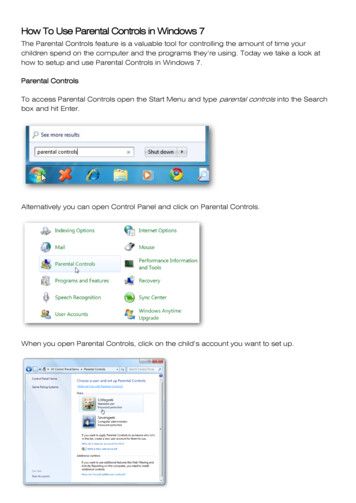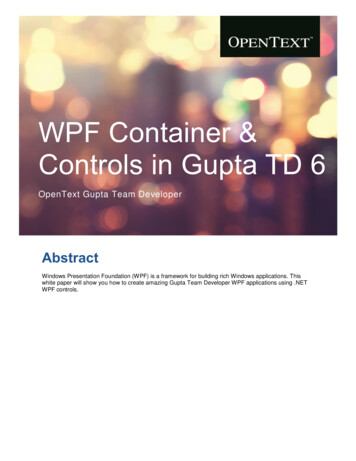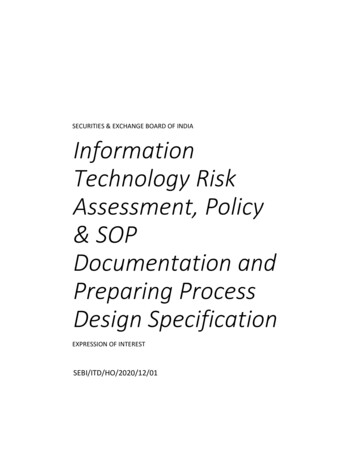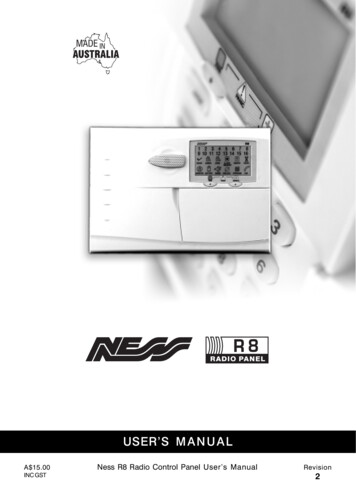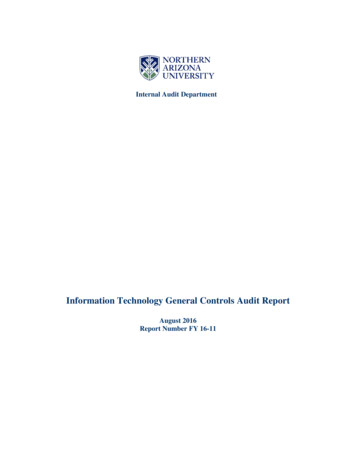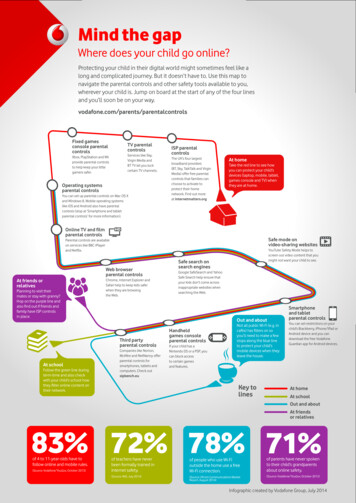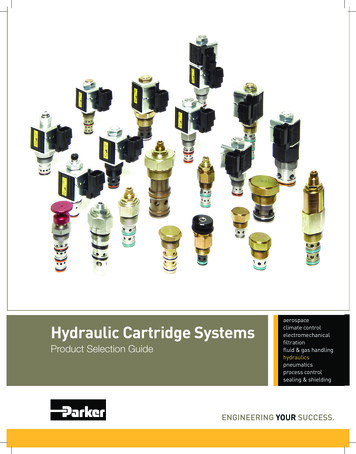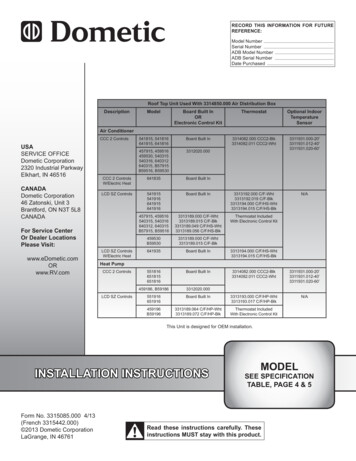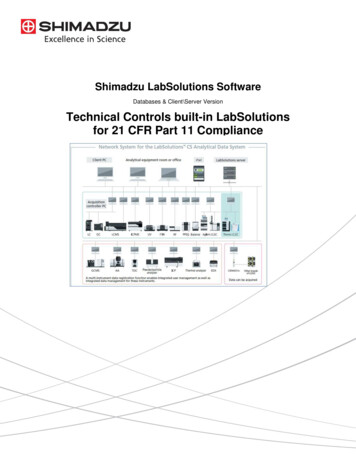
Transcription
Shimadzu LabSolutions SoftwareDatabases & Client\Server VersionTechnical Controls built-in LabSolutionsfor 21 CFR Part 11 Compliance
Disclaimer(1) Shimadzu Corporation retains the copyright over this document. The contents of this documentmust not be reproduced or copied in total or in part without the express permission of ShimadzuCorporation.(2) The contents of this document may be changed without notice.(3) Great care was taken when preparing this document. However, any errors or omissionscontained may not be corrected immediately.For technical enquiries, contact your Shimadzu e Number: 1-800-477-12272
1.Introduction 42.Outline and Structure of FDA 21 CFR Part 11 42.1.3.Definitions 5Equivalence Between FDA 21 CFR Part 11 Requirements and Shimadzu LabSolutions Database andShimadzu LabSolutions Client/Server Software 63.1.4.Basic Policy for FDA 21 CFR Part 11 Compliance 6FDA 21 CFR Part 11 – compatible Shimadzu Software 94.1.LabSolutions Database and Client\Server Software can be used to achieve FDA 21 CFR Part 11compliance compatible with the following Shimadzu Hardware. 94.2.Software configuration 94.3.Software operating environment 105.Subpart B Electronic Records 105.1.Sec. 11.10 Controls for closed systems 105.2.Sec. 11.30 Controls for open systems 195.3.Sec. 11.50 Signature manifestations 195.4.Sec. 11.70 Signature/record linking 216.Subpart C Electronic Signatures 216.1.Sec. 11.100 General requirements. 216.2.Sec. 11.200 Electronic signature components and controls 226.3.Sec. 11.300 Controls for identification codes/passwords 234. Compatibility of Shimadzu LabSolutions Database and LabSolutions Client/Server software with FDA 21CFR Part 11 Requirements 265. Inquiries 31Page 3 of 34
6. Revision Information 32IntroductionOn August 20, 1997 the United States FDA (Food and Drug Administration) issued theregulations pursuant to 21 CFR Part 11. These regulations provide guidelines on usingelectronic records and electronic signatures (ER/ES) by defining the criteria under whichelectronic records and electronic signatures are considered to be trustworthy, reliable, andequivalent to paper records with handwritten signatures. It also provides guidelines forsubmission of electronic records to the FDA.This paper describes the tools provided by the LabSolutions Database and Client/Serversoftware to assist Shimadzu customers with 21 CFR Part 11 regulatory compliance.Outline and Structure of FDA 21 CFR Part 11The structure of 21 CFR Part 11 document is shown below:Subpart A – General Provisions11.1 Scope.11.2 Implementation.11.3 Definitions.Subpart B – Electronic Records11.10 Controls for closed systems.11.30 Controls for open systems.11.50 Signature manifestations.11.70 Signature/record linking.Subpart C – Electronic Signatures11.100 General requirements.11.200 Electronic signature components and controls.11.300 Controls for identification codes/passwords.Subpart A relates to general provisions, including definitions of terminology.Subpart B and Subpart C cover the requirements for the software and data system.The equivalence between the requirements of Subpart B and Subpart C and theShimadzu software is described below.Page 4 of 34
DefinitionsSection 11.3 defines the terminology related to FDA 21 CFR Part 11.11.3(b)-(3) BiometricsThe identification of an individual from physical characteristics, such as fingerprints.11.3(b)-(4) Closed systemAn environment in which system access is controlled by persons who are responsible forthe content of all electronic records that are on the system.11.3(b)-(5) Digital signatureElectronic signatures based on cryptographic methods for author identification and dataprotection.11.3(b)-(6) Electronic recordAny combination of text, graphics, data, audio, pictorial, or other information representationin digital form that is created, modified, maintained, archived, retrieved, or distributed by acomputer system.11.3(b)-(7) Electronic signatureA means of identifying an individual in a computer system that is the legal equivalent of ahandwritten signature.11.3(b)-(9) Open systemAn environment in which system access is not controlled by persons who are responsiblefor the content of electronic records that are on the system.Page 5 of 34
Equivalence Between FDA 21 CFR Part 11 Requirements and Shimadzu LabSolutionsDatabase and Shimadzu LabSolutions Client/Server SoftwareBasic Policy for FDA 21 CFR Part 11 ComplianceShimadzu achieves FDA 21 CFR Part 11 compliance through integrated control of data forHPLC, GC, LCMS, ICPMS, UV, FTIR, RF, PPSQ, Balance, GCMS, AA, TOC, ParticleAnalyzers, Thermal Analyzer, and EDX instruments.Shimadzu supplies products and technologies based on LabSolutions Database andLabSolutions Client/Server to assist with FDA 21 CFR Part 11 compliance for analyticaldata from laboratory instruments, such as chromatographs and balances.Access to LabSolutions Database and LabSolutions Client/Server software is controlled byUser IDs and passwords. Linking to Windows XP / Windows 7 / Windows 10 and databasemanagement software (SQL Server) security functions achieves reliable data protection.Introduction of LabSolutions software can create a closed system as defined in provision §11.3 of the Part 11 document.Page 6 of 34
LabSolutions Login ScreenTo permit easy checking of data, the LabSolutions screen is divided into multiple areas as shown below. Theinterface is compatible with electronic signatures.Select theanalyticaldata hereDataFilteringPeak reportdisplayPage 7 of 34
To support customer compliance with FDA regulations, Shimadzu compiles the latestinformation on FDA regulations, develops products based on this information, promotescustomer education on compliance issues via seminars and other means, providescustomer assistance and offers support for FDA inspections.Customer demands regarding FDA compliance(1)Products supporting FDA compliance(3) Complying with vendor inspections(2)(1) Products supporting FDAcompliance(3) Complying with vendorinspections* S/W supporting Part 11 compliance* Computer validation* Automated validation of S/W* Software validation* PC networkSupport* Establishment of in-house programs(such as ISO, GMP)for FDAcomplianc(2) Support for various types ofvalidation(4) Providing the latest informationfrom the FDA* Periodic FDA seminars* IQ/OQ of analytical instruments* Computer validation* FDA Seminar 2001: ElectronicSignatures, Electronic Records* Various types of validation* FDA Seminar 2000: FDA InspectionPage 8 of 34
FDA 21 CFR Part 11 –Shimadzu Software CompatibilityLabSolutions Database and Client\Server Software can be used to achieve FDA 21 CFRPart 11 compliance compatible with the following Shimadzu Hardware.Shimadzu LC SystemsShimadzu PPSQ SystemsShimadzu GC SystemsShimadzu AA SystemsLabSolutions LCMS SystemsShimadzu TOC SystemsLabSolutions GCMS SystemsShimadzu Particle AnalyzersShimadzu ICPMS SystemsShimadzu Thermal AnalyzersShimadzu UV SystemsShimadzu EDX InstrumentsShimadzu FTIR SystemShimadzu BalancesShimadzu RF SystemsLabSolutions Database and LabSolutions Client/Server software can be used to helpachieve FDA 21 CFR Part 11 compatibility for the listed Shimadzu programs.Software configurationLabSolutions Database and LabSolutions Client/Server software can used to maintaindata and assist with 21CFR Part 11 compliance.All data collected by the LabSolutions Database and LabSolutions Client/Serversoftware is stored in a Secure, access-controlled SQL database.Electronic Signatures can be added to any and all data within the LabSolutionsDatabase and LabSolutions Client/Server software. The signatures are then storedwith the data in the database.Electronic records (Audit Trails) are kept for all data that is stored within the database.All data in the LabSolutions Database and LabSolutions Client/Server software can beprocessed at will and then used to generate reports that can be printed on anyprinter that the computer hosting LabSolutions Database and LabSolutionsClient/Server software has access to.Data that is saved in the secure database can be browsed or searched using theLabSolutions Database and LabSolutions Client/Server software but only by peoplewho have the proper permissions within LabSolutions Database and LabSolutionsClient/Server software to access the data.LabSolutions Database and LabSolutions Client/Server software keeps all old versionsof data and reports and they can be recalled as needed.Page 9 of 34
LabSolutions incorporates security and user management functions that areindependent of the hosts operating system features. A user name (User ID) andpassword must be entered before using these programs.Software operating environmentLabSolutions Software runs under Windows XP professional 32 bit, or Windows 7professional 32 and 64 bit, and Windows 10 professional 64bit.The hard disk drive where LabSolutions is installed and the LabSolutions database isconfigured must be formatted as an NTFS (New Technology Filing System) drive.Subpart B Electronic RecordsSec. 11.10 Controls for closed systemsPersons who use closed systems to create, modify, maintain, or transmit electronicrecords shall employ procedures and controls designed to ensure the authenticity,integrity, and, when appropriate, the confidentiality of electronic records, and to ensurethat the signer cannot readily repudiate the signed record as not genuine. Suchprocedures and controls shall include the following:(a) Validation of systems to ensure accuracy, reliability, consistent intendedperformance, and the ability to discern invalid or altered records.Validation of systems to ensure accuracy, reliability, consistent intendedperformance, and the ability to discern invalid or altered records are incorporatedas software functions and are verified to operate according to the specificationsat the development stage. Therefore, when a customer conducts softwarevalidation, it is necessary to ensure that no alteration of the installed softwarehas occurred. Shimadzu supports validation operations by issuing an IQ(Installation Qualification) Protocol to confirm that installation was conductedcorrectly and OQ (Operational Qualification) Protocol that defines periodicsystem checks.Page 10 of 34
(b) The ability to generate accurate and complete copies of records in both humanreadable and electronic form suitable for inspection, review, and copying by theagency. Persons should contact the agency if there are any questions regarding theability of the agency to perform such review and copying of the electronic records.Data generated by this system contains all the required information provided inthe table below. This information is stored in a single file and cannot beseparated, allowing for a complete record to be retained in a machine-readableformat. An accurate report can also be produced in a human-readable form.This capability to generate accurate and complete copies of data in both humanreadable and electronic form supports submission of reports for inspections.LabSolutions Data FileProperties InformationSample information (Sample Name, Sample ID, Vial No. etc.)Names of files used for analysis and re-analysisNames of users who created or edited dataDate and time when data was created or editedCommentsData Acquisition InformationChromatogramsSystem configuration and instrument control methodsPage 11 of 34
Data processing methods (original data; including peak integrationprograms)Status information (analyzer operation log during data acquisition)Batch table (for analysis batch processing data)Data Analysis Information (including first analysis at the time of dataacquisition)Analysis resultsData processing methods (the latest data; including peak integrationprograms)Data processing methods (audit trail log for analysis records)Report format (for data outputted as a report)Batch table (for re-analysis batch processing data)(c) Protection of records to enable their accurate and ready retrieval throughout therecords retention period. Protection of recordsData files are stored together with meta data (methods, schedules, etc.) in a safe,access-controlled SQL Server database. Rapid searchingLabSolutions search function allows for a ready record retrieval as data files arestored in a database. Recovering recordsData can be archived to removable media, such as CD-R for long-term storage.This data can be referenced directly from the CD, without copying it back to thehard disk, and can be fully recovered to its original state from the database, whenrequired.Page 12 of 34
(d) Limiting system access to authorized individuals.Access to the system is limited, as the system requires input of a User ID andpassword before the system can be used. LabSolutions allows access to eachfunction to be set separately for each user.(e) Use of secure, computer-generated, time-stamped audit trails to independentlyrecord the date and time of operator entries and actions that create, modify, ordelete electronic records. Record changes shall not obscure previously recordedinformation. Such audit trail documentation shall be retained for a period at least aslong as that required for the subject electronic records and shall be available foragency review and copying.Page 13 of 34
LabSolutions software maintains three different logs: the data log that recordsoperations conducted on the analytical data; the system log that records systemlogins, logouts and changes to the environment settings; and the userauthentication log that records changes to user registration details. These logsare generated automatically by the software and kept in database.These logs are mutually independent as the method of control is different foreach one: the data log is controlled along with the data it relates to and thesystem log is saved separately from specific data.Each time a new analysis or data reprocessing is performed, calculated results,method, schedule and raw data is automatically saved in a database along withthe audit trail. This data is protected from being overwritten or deleted, therebyensuring an adequate audit trail capability.System Administration LogPage 14 of 34
Application LogUser Authentication LogPage 15 of 34
Data Stored in the Database(f) Use of operational system checks to enforce permitted sequencing of steps andevents, as appropriate.This system offers schedule and method (including time programs) functionsthat permit customer to preset sequences. The schedules and methods arestored in the database with analysis results when an analysis is run, allowingconfirmation that the analysis has been run according to the sequence.(g) Use of authority checks to ensure that only authorized individuals can use thesystem, electronically sign a record, access the operation or computer system inputor output device, alter a record, or perform the operation at hand.This system offers authority check functions that set the authority each user hasfor each instrument and function. Unauthorized people are prevented fromaccessing an instrument or function.Page 16 of 34
User ControlUser Information Entry(h) Use of device (e.g., terminal) checks to determine, as appropriate, the validity of thesource of data input or operational instruction.The unit configuration is stored for each method at the time the method iscreated. When measurement is commenced an error is generated if the actualunit configuration differs from the unit configuration stored for the method.Another function is provided to read and display the instrument serial number.Page 17 of 34
(i) Determination that persons who develop, maintain, or use electronicrecord/electronic signature systems have the education, training, and experience toperform their assigned tasks.When creating or reviewing specification requirements during development of aFDA 21 CFR Part 11-compliant system, Shimadzu verifies that the FDA 21 CFRPart 11 requirements are satisfied. Also, Shimadzu contracts a specialistconsultant to evaluate and provide feedback for the required specifications.Education and training is provided to maintenance and service engineers. Anauthentication system has been implemented for staff involved with themaintenance and servicing of FDA 21 CFR Part 11-compliant systems.Shimadzu provides training courses for customers using FDA 21 CFR Part 11compliant systems.(j) The establishment of, and adherence to, written policies that hold individualsaccountable and responsible for actions initiated under their electronic signatures, inorder to deter record and signature falsification.This item shall be declared and implemented in the "SOP for FDA 21 CFR Part 11Compliance" created by the customer.Page 18 of 34
(k) Use of appropriate controls over systems documentation including:(1) Adequate controls over the distribution of, access to, and use of documentationfor system operation and maintenance.(2) Revision and change control procedures to maintain an audit trail thatdocuments time-sequenced development and modification of systemsdocumentation.Instruction Manuals are supplied with Shimadzu products or they can bepurchased separately.Development documents and Instruction Manuals shall be handled throughoutthe software lifecycle using a quality control system conforming to ISO9001.This quality control system shall define procedures for document revision andchange control. A record of revisions made to documents shall be kept.Sec. 11.30 Controls for open systemsPersons who use open systems to create, modify, maintain, or transmit electronicrecords shall employ procedures and controls designed to ensure the authenticity,integrity, and, as appropriate, the confidentiality of electronic records from the point oftheir creation to the point of their receipt. Such procedures and controls shall includethose identified in Sec. 11.10, as appropriate, and additional measures such asdocument encryption and use of appropriate digital signature standards to ensure, asnecessary under the circumstances, record authenticity, integrity, and confidentiality.This item is not applicable as this system is designed for configuration as a closedsystem.(If electronic mail functions are used in a system connected to the Internet,appropriate control measures must be undertaken or the system will beconsidered an open system. In this situation, disable the electronic mailfunctions.)Sec. 11.50 Signature manifestations(a) Signed electronic records shall contain information associated with the signing thatclearly indicates all of the following:(1) The printed name of the signer;(2) The date and time when the signature was executed; andPage 19 of 34
(3) The meaning (such as review, approval, responsibility, or authorship)associated with the signature.(b) The items identified in paragraphs (a)(1), (a)(2), and (a)(3) of this section shall besubject to the same controls as for electronic records and shall be included as partof any human readable form of the electronic record (such as electronic display orprintout).The electronic signatures function of this system incorporates the printed nameof the signer, date and time when the signature was executed and the meaningassociated with the signature (such as approval). The signatures are displayedwith these elements in the electronic records list.Page 20 of 34
Sec. 11.70 Signature/record linkingElectronic signatures and handwritten signatures executed to electronic recordsshall be linked to their respective electronic records to ensure that the signaturescannot be excised, copied, or otherwise transferred to falsify an electronic record byordinary means.Signature information is stored in the same field as the database record and iscontrolled in the same way as the record. The signature information issimultaneously retained in the operation log. The operation log is linked to thedatabase where the corresponding record is stored. The contents of theoperation log cannot be copied or moved and the operation log can be deletedonly after it is archived.Subpart C Electronic SignaturesSec. 11.100 General requirements.(a) Each electronic signature shall be unique to one individual and shall not be reusedby, or reassigned to, anyone else.This system does not permit the same User ID or user name to be assigned todifferent individuals. It is possible to prohibit user account deletion. Althoughusers can be disabled. Consequently, each electronic signature is unique to oneindividual.(b) Before an organization establishes, assigns, certifies, or otherwise sanctions anindividual's electronic signature, or any element of such electronic signature, theorganization shall verify the identity of the individual.(c) Persons using electronic signatures shall, prior to or at the time of such use, certifyto the agency that the electronic signatures in their system, used on or after August20, 1997, are intended to be the legally binding equivalent of traditional handwrittensignatures.(1) The certification shall be submitted in paper form and signed with a traditionalhandwritten signature, to the Office of Regional Operations (HFC-100), 5600Fishers Lane, Rockville, MD 20857.(2) Persons using electronic signatures shall, upon agency request, provideadditionalcertification or testimony that a specific electronic signature is the legallybindingequivalent of the signer's handwritten signature.Page 21 of 34
This item relates to standard operating procedures. The details above must beincorporated in the SOP created by the customer.Sec. 11.200 Electronic signature components and controls(a) Electronic signatures that are not based upon biometrics shall:(1) Employ at least two distinctive identification components such as anidentification code and Password.Electronic signatures used by this system employ two distinctive identificationcomponents: a User ID and a password.(i). When an individual executes a series of signings during a single continuousperiod of controlled system access, the first signing shall be executed using allelectronic signature components; subsequent signings shall be executedusing at least one electronic signature component that is only executable by,and designed to be used only by the individual.(ii). When an individual executes one or more signings not performed during asingle, continuous period of controlled system access, each signing shall beexecuted using all of the electronic signature components.This system requires a User ID and password to initially log into the system.Subsequently, the user selects and checks the contents of the data to be signedand must then re-input his/her password for each subsequent signing. Afterlogging off the system, the user must subsequently repeat all the operationsabove.Consequently, to make a series of signings, the User ID and password arerequired for the first signing. Input of the password alone is sufficient forsubsequent signings.(2) Be used only by their genuine owners; and(3) Be administered and executed to ensure that attempted use of an individual'selectronic signature by anyone other than its genuine owner requirescollaboration of two or more individuals.Even the system administrator is unable to obtain the password of another person.Because only the genuine owner knows the correct combination of User ID andpassword, no other single person can falsify the signature of the genuine owner.Page 22 of 34
(b) Electronic signatures based upon biometrics shall be designed to ensure that theycannot be used by anyone other than their genuine owners.The current version is does not support signatures based on biometrics.Sec. 11.300 Controls for identification codes/passwordsSec 11.300 Controls for identification codes/passwordsPersons who use electronic signatures based upon use of identification codes incombination with passwords shall employ controls to ensure their security andintegrity. Such controls shall include:(a) Maintaining the uniqueness of each combined identification code and password,such that no two individuals have the same combination of identification code andpassword.This system does not permit a User ID to be deleted once it has been registered.(Although it can be disabled.) It is not possible to register a User ID that wasregistered previously. Consequently, it is impossible to assign an identicalcombination of User ID and password to more than one person.(b) Ensuring that identification code and password issuance is periodically checked,recalled, or revised (e.g. to cover such events as password aging).The minimum password length and period of validity can be set to preventpassword obsolescence. Unwanted User IDs can be disabled.Page 23 of 34
(c) Following loss management procedures to electronically reauthorize lost, stolen,missing, or otherwise potentially compromised tokens, cards, and other devices thatbear or generate identification code or password information, and to issue temporaryor permanent replacements using suitable, rigorous controls.The system administrator of this system can disable accounts and issue new UserID’s and passwords. The system administrator can also reset a password for aperson who forgot his/her password.Page 24 of 34
(d) Use of transaction safeguards to prevent unauthorized use of passwords and/oridentification codes, and to detect and report in an immediate and urgent mannerany attempts at their unauthorized use to the system security unit, and, asappropriate, to organizational management.This system administrator can preset maximum number of unsuccessful loginattempts after which the user ID is deactivated for a time period that can also bepreset by the system administrator. An electronic mail can automatically be sentto designated addresses, as shown below.The system is therefore able to detect and notify attempts at unauthorized access.(e) Initial and periodic testing of devices, such as tokens or cards, that bear orgenerate identification code or password information to ensure that they functionproperly and have not been altered in an unauthorized manner.This item does not apply to this system; as such devices are not used.This completes the outline of the FDA 21 CFR Part 11-compliance of Shimadzu analyticalinstruments using LabSolutions Database and LabSolutions Client/Server software.Contact your Shimadzu representative if you require these documents.Page 25 of 34
4. Compatibility of Shimadzu LabSolutions Database and LabSolutions Client/Serversoftware with FDA 21 CFR Part 11 RequirementsThe tables below list the compatibility of Shimadzu LabSolutions Database andLabSolutions Client/Server software with items of FDA 21 CFR Part 11.The tables relate to a closed system configuration, with the Windows environment anddatabases recommended by Shimadzu installed.Subpart B Electronic Records11.10 Procedures and Management for a Closed SystemQuestionCompatibility11.10(a)Is the system validated?Yes11.10(a)Can invalid records and altered records be identified?Yes11.10(b)Can the system print an accurate and complete hardcopy ofelectronic records to paper?Yes11.10(b)Does the system offer functions to create an accurate andcomplete copy in electronic format for FDA audits, inspectionsand copies?Yes11.10(c)Is rapid restoration of electronic records possible throughout thestorage period?Yes11.10(d)Is system access restricted to people with access authority?Yes11.10(e)Is a computer-generated audit trail available that records the dateand time? The audit trail must record the date and time ofoperator inputs, electronic report generation, and modificationsand deletions.Yes11.10(e)Is previous information retained after an electronic record ismodified? (Record does not become vague.)Yes11.10(e)Is restoration of the electronic-record audit trail possiblethroughout the storage period?Yes11.10(e)Is the audit trail compatible with FDA inspections and copies?Yes11.10(f)When system operation and operation sequence are critical, canthe system control the operation procedure? (For a processcontrol system, for example.)YesPage 26 of 34
Does the system ensure the following?Electronic signatures to electronic records?11.10(g)Access to I/O devices for operation or computer system?YesRecord editing and other operations possible by approvedpersonnel only?11.10(h)If the system allows input of data and work instructions only froman input device (a terminal, for example), is a validity checkconducted on all data and work instructions received by thesystem? (Note: This applies to systems in which data or workinstructions can be generated by multiple input devices. In thiscase, the system must conduct integrity verification of networklinked data sources, such as balances and wireless remotecontrolled terminals.)Yes11.10(i)Are OJT and other training documents available to for systemusers, developers, and IT support?Yes11.10(j
software to assist Shimadzu customers with 21 CFR Part 11 regulatory compliance. Outline and Structure of FDA 21 CFR Part 11 The structure of 21 CFR Part 11 document is shown below: Subpart A - General Provisions 11.1 Scope. 11.2 Implementation. 11.3 Definitions. Subpart B - Electronic Records 11.10 Controls for closed systems.

